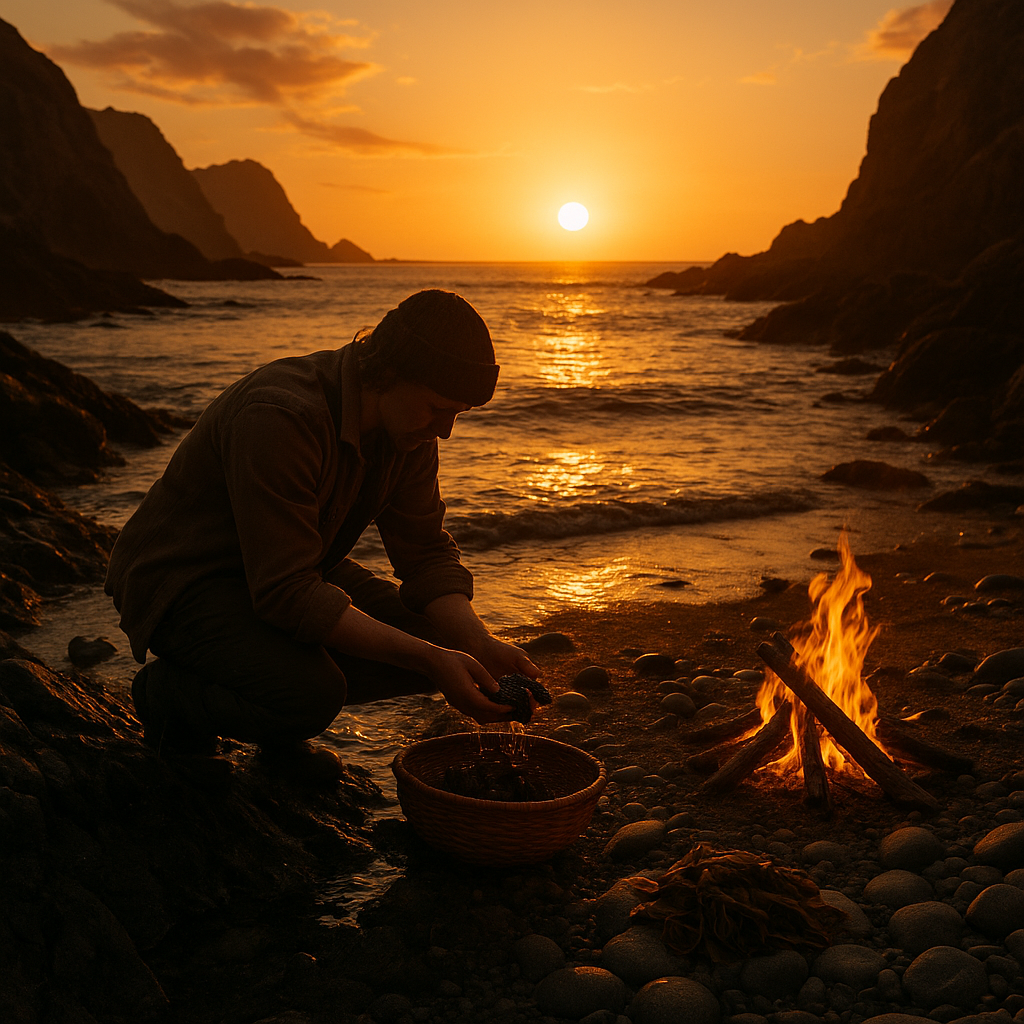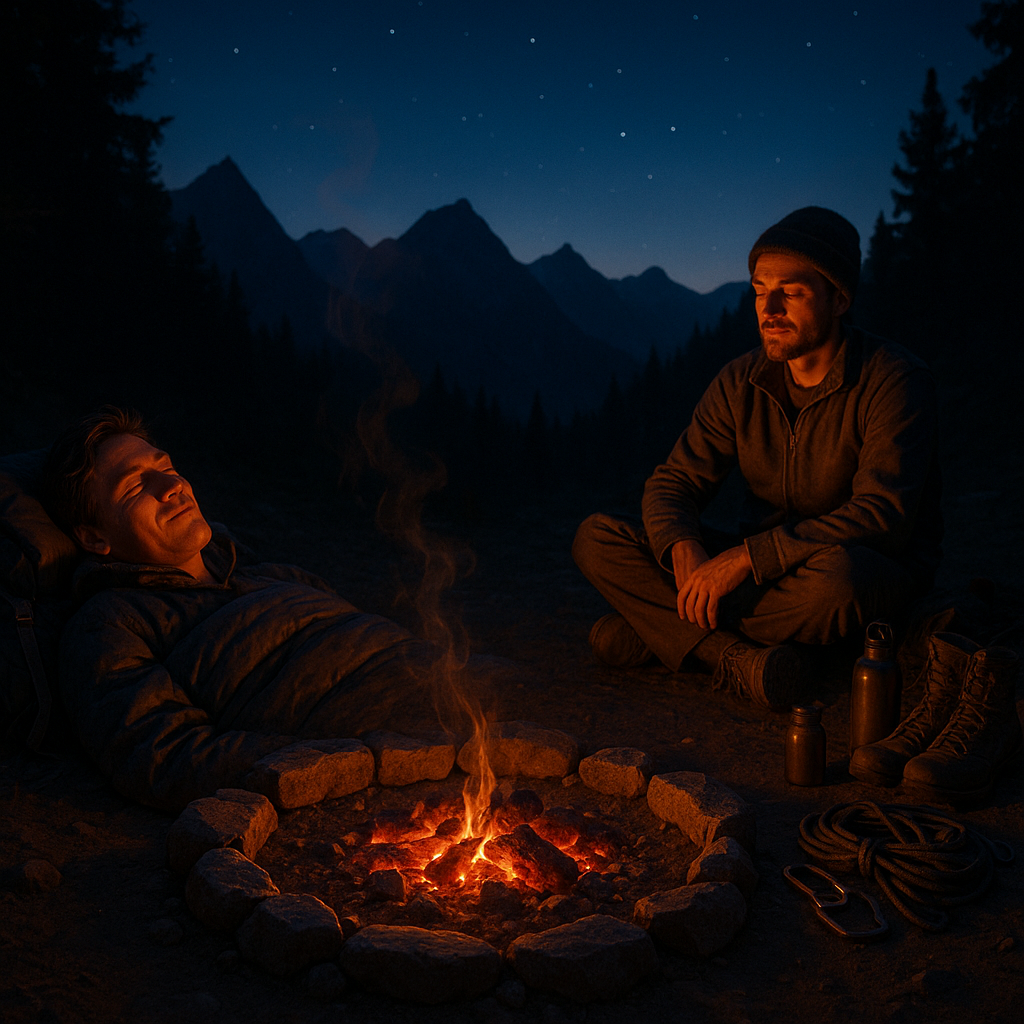Key Takeaways
- Embrace the riches of the shoreline: The coast is a living pantry, overflowing with edible treasures such as shellfish, seaweed, wild greens, and berries. These ingredients do more than simply feed you; they elevate your meals, transforming survival into an authentic and memorable experience.
- Transform foraging into a culinary journey: Coastal foraging is far more than just collecting food. It invites you to immerse in the landscape, learning to identify, gather, and honor local ingredients, whether you are prying mussels from tidal rocks or chasing after wild greens sprouting in the sand.
- Master the art of simple seafood survival cooking: With only a campfire, a makeshift grill, or a few hot rocks, you can turn the day’s catch into nourishing meals. Techniques like grilling fresh fish on green sticks, steaming clams with seaweed, or slow-roasting seafood in natural wraps awaken primal flavors and require little equipment.
- Optimize nutrition through mindful selection: Wild coastal foods deliver robust nutrition, rich in protein, minerals, and healthy fats. These foods often surpass standard emergency rations. By choosing sustainably and harvesting respectfully, you nourish both yourself and the environment.
- Utilize timeless preservation methods: Natural tools like salt, sun, and smoke have preserved coastal foods for generations. Drying seaweed, curing fish, and sun-drying wild greens make for longer-lasting, travel-ready rations, eliminating the need for modern refrigeration.
- Reimagine survival food with vibrant flavor: Coastal survival meals offer more than mere sustenance. Season your catch with wild herbs, smoked sea salt, or edible seaweed to elevate necessities into flavorful, soul-satisfying feasts.
When you blend practical foraging skills, elemental cooking techniques, and the untamed energy of the shore, you create much more than a meal. Each coastal survival feast is a celebration of nature’s abundance and your own creative spirit. Step into the briny air, and let’s explore hands-on recipes, expert foraging tips, and traditional coastal methods for meals you’ll never forget.
Introduction
When the tide pulls back, it reveals a feast tucked into every nook and cranny along the shore. Mussels clustered on rocks, wild greens thriving amidst stones, and seaweed shimmering in the gentle light. Cooking on the coast is an invitation to connect deeply with the earth and sea. It’s not just survival, but a celebration of the landscape itself, where each smoky bite becomes a bridge between nature and memory.
Coastal survival meals invite you to slow down, forage with intention, and savor ingredients that echo the rhythms of wind and tide. Through practical gathering advice, simple fire-based cooking tips, and mindful meal preparation, you can discover how easily an ordinary shoreline transforms into a soul-nourishing, open-air kitchen. Let’s gather with salty hands and embark on a journey where the food is as wild as the view.
Discovering Edible Treasures Along the Coast
Beyond the edge of land, where sand and sea entwine, an entire world of edible flora and fauna waits to be found. Every stretch of coastline holds a seasonal pantry, shaped by wind, tides, and sunlight.
Stay Sharp. Stay Ahead.
Join our Telegram Channel for exclusive content, real insights,
engage with us and other members and get access to
insider updates, early news and top insights.
 Join the Channel
Join the Channel
Shellfish: Mussels, clams, and oysters cling to rocks or nestle in tidal flats. When foraging, search for tightly closed shells in clean, flowing water. Always consult local guidelines to avoid contaminated waters or times of harmful algal blooms. Harvesting these briny delicacies offers both nutrition and a grateful connection to a cycle that has sustained coastal dwellers for centuries.
Seaweeds and Coastal Greens: Robust varieties like dulse, kelp, and nori are easily harvested at low tide. Rinse off sand and enjoy them raw, steamed, or crisped over fire. Edible greens such as sea rocket and wild purslane thrive near dunes, lending a tangy freshness and a burst of nutrients to your meals.
Crustaceans and Fish: Small crabs, shrimp, and fish await in tidal pools or can be caught with minimal gear. Always adhere to local size and harvest limits to preserve the ecosystem for generations to come. Across the globe, from the mangrove estuaries of Southeast Asia to rocky Mediterranean coasts, communities have relied on these resources for millennia.
Wild Berries and Edible Blooms: Thickets along the shore conceal treasures such as beach strawberries, rose hips, or edible blossoms. These wild treats burst with color and flavor, brightening even the simplest fire-grilled meal.
Drawing inspiration from coastal communities worldwide (like families in Nova Scotia who teach younger generations to forage for periwinkles, or Scandinavian traditions of kelp gathering), you join a lineage that honors both tradition and the wild. With each mindful step and careful harvest, foraging along the coast becomes an act filled with reverence and gratitude, rooting your meals in a sense of place.
Turning Foraging Into a Culinary Adventure
Once your basket is full, the shoreline itself becomes your kitchen. Every meal is an act of improvisation, creativity, and playful invention, rooted in the surroundings and the unique harvest you’ve gathered.
Imagine a sunset gathering as a group of friends cook over driftwood flames: seaweed crackling above orange embers, mussels gently steaming with handfuls of wild herbs, flat stones warming a salad of just-picked greens. Coastal cooking asks you to step away from rigid recipes and instead trust your senses, letting place and season guide what’s possible.
A few favorite examples include:
- Mussels wrapped in kelp create their own tender, briny steam packets, absorbing natural salt while locking in moisture and minerals.
- Fireside-roasted crab offers smoky richness enhanced by wild fennel or a squeeze of sharp sorrel gathered from nearby dunes.
- Dulse chips sizzle to crispy perfection on hot stones, bringing bursts of umami and crunch.
- Vivid wild green salads featuring beach peas, purslane, and dandelion, tossed with rose hip vinaigrette, offer tart freshness in even the most basic meal.
Practicality and adventure intertwine on the coast. Small groups stranded by rising tides in Oregon once used driftwood and mussel shells as makeshift cookware, crafting a memory far richer than any packaged meal. Whether solo or in good company, the experience of shared cooking in wild places is nourishing beyond the plate.
The essence of coastal survival isn’t about hardship, but about finding joy and wonder in resourcefulness. With every new ingredient and makeshift technique, you build confidence and forge memories that outlast the meal. Now, with fresh food in hand, let’s explore hands-on ways to transform your wild harvest into delicious nourishment.
Seafood Survival Cooking: Practical Beachside Techniques
The shoreline transforms into a rustic kitchen where adaptability, fire, and ingenuity rule the day. Cooking with seafood and wild edibles calls for both respect and creativity, letting the ancient elements of fire and stone do the work.
1. Open-Fire Grilling:
Arrange driftwood in a teepee shape, and place fish fillets directly onto green twigs or flat hot stones. A sprinkle of wild herbs and a splash of seawater create a natural brine. Fire infuses each bite with a smoky depth, allowing the flavors of the coast to shine.
2. Rock Ovens:
Heated stones assembled into a primitive oven provide even, radiant heat. Use this to roast crabs or wild roots, or to bake simple flatbreads mixed from foraged grain and seawater. Across cultures from the South Pacific to Arctic Scandinavia, stone ovens have been a staple technique for communal feasts.
3. Seaweed Steam Pits:
Dig a shallow pit, line it with hot rocks and fresh seaweed, layer on your catch, and top with more seaweed and sand. The rising steam gently cooks shellfish, infusing them with oceanic flavor. This approach draws from traditions worldwide, including the clambakes of Native peoples in the Pacific Northwest and the hangi of Maori communities.
4. Improvised Utensils:
Mussel shells double as scoops or spoons, while split sticks or bamboo serve as skewers. Even in the absence of modern gear, the shoreline supplies versatile, biodegradable tools for every task.
In every region, from wind-swept Scottish beaches to calm bays in Southeast Asia, these elemental techniques create not just meals, but stories and rituals that linger long after the last coals have faded. Safety and stewardship come first: extinguish all fires thoroughly, avoid contaminated driftwood or plastics, and cook only in clean, protected areas.
Stay Sharp. Stay Ahead.
Join our Telegram Channel for exclusive content, real insights,
engage with us and other members and get access to
insider updates, early news and top insights.
 Join the Channel
Join the Channel
At the fire’s side, with plate in hand, coastal cooks find not just sustenance, but profound connection. There’s a sense of togetherness kindled by the shared act of feeding body and spirit. Yet while the gathering and cooking are exhilarating, the real magic lies in how these wild foods nourish you in ways traditional survival rations cannot.
Maximizing Nutrition and Flavor in Coastal Survival Meals
In the world of emergency food, few meals can rival what the wild coastline offers. Each bite is alive with both flavor and life-sustaining nutrition, a world apart from shelf-stable, preservative-laden rations.
- Abundant Protein: Mussels, clams, fish, and crabs provide highly digestible protein alongside omega-3 fatty acids critical for brain, heart, and immune health. These nutrients are too often missing in processed survival foods.
- Mineral Wealth: Seaweed and coastal greens are rich in calcium, iron, iodine, magnesium, and potassium, supporting everything from thyroid function to muscle health. Just a handful of dried seaweed makes a potent addition to any meal.
- Antioxidant Power: Wild berries and greens deliver vitamins A, C, and E, strengthening immunity, supporting recovery after exertion, and offering a burst of energy that outshines any generic trail bar.
The experience is not just about nourishment, but pleasure. The subtle saltiness of just-cooked seaweed, the tangy snap of purslane, the satisfying char on grilled fish: these are flavors that linger. Minimal seasoning and primitive fire unleash each ingredient’s essence, turning even the most spare meal into a feast.
Case studies speak volumes; along Norway’s coast, outdoor education groups found wild-foraged foods kept morale high, boosted satiety, and offered lasting energy in contrast with the fatigue and boredom of processed rations.
Wild foods are gifts with fleeting availability. Learning ancient preservation methods is the next step in ensuring the ocean’s bounty sustains you for the long journey ahead.
Natural Preservation Methods for Coastal Foods
The beauty of the coast is dynamic, and so are the possibilities for turning today’s catch into provisions that last. Drawing upon ancient wisdom and simple materials, natural preservation sustains the spirit of the shoreline long after the fire is out.
- Sun and Air Drying: Thread strips of seaweed, fish, or greens onto twine, and hang them in a breezy, sunlit spot above the high water line. Within hours, you’ll have snacks and ingredients to last for days. This practice is celebrated in climates from Maine to the shores of Japan. To learn more about natural seasoning for your preserved foods, discover the techniques of sun-dried herbs.
- Salting and Curing: Scattering layers of sea salt on freshly cleaned fish draws out moisture. Within hours or days, you’re left with concentrated protein that stores well and doubles as a savory base for future meals.
- Smoking Over Natural Wood: Hot or cold smoking, using driftwood or foraged hardwood, preserves fish and shellfish while imparting deep, complex flavors. Smoked foods stay edible for much longer, offering both practicality and culinary delight.
- Fermentation: For those feeling adventurous, packing foraged greens and seaweed with salt in jars encourages fermentation. Days later, you’ll discover probiotic-rich, tangy bites that can transform future campfire stews. For ideas on how to ferment outdoors, see the guide on campfire fermentation.
Nature’s preservation tools are timeless and require little more than patience and awareness of your environment. For example, adventurers paddling the rugged British Columbia coast have successfully stretched limited provisions by drying seaweed and lightly smoking the seafood catch, increasing their food stores and morale on multi-day journeys.
These preservation methods also tread gently on the landscape, relying on nature’s bounty instead of single-use packaging or chemicals. Preserved wild foods become both sustenance and inspiration, waiting to enliven your next open-air feast.
Practical Tips for Unforgettable Coastal Survival Meals
Ready to make every shoreline meal an experience worth savoring? A bit of planning, some respect for local rhythms, and an appreciation for simplicity will help transform your next coastal adventure into a story you’ll want to tell again and again.
- Scout Ahead: Consult local regulations, pay attention to restricted species or protected areas, and study tide charts. Knowledge is both safety and empowerment. Locals and indigenous communities often offer guidance beyond what a website can provide. If you seek even deeper traditions, explore the foods and fire rituals in indigenous foodways.
- Travel Light, Rely on Nature: Bring only what you can’t easily find: a firestarter, a sturdy knife, a small pan, and a pinch of salt. Let the land supply utensils, fuel, and most of your ingredients.
- Prioritize Safety: Always double-check the identities of wild foods. Shellfish should be collected only in safe conditions, and unknown plants should be avoided unless you’re certain. When in doubt, err on the side of caution.
- Cook It Fresh: Wild-caught seafood and greens are best eaten or preserved the same day. Rapid spoilage is a risk in warm, humid climates.
- Leave No Trace: Pack out every bit of litter and food waste. Compost scraps well away from water sources. This stewardship ensures that the magic of coastal cooking endures for future explorers.
- Be Present: Take time to pause between each step. Let your senses drink in the surf’s rhythm, the scent of smoke, and the warmth of sand underfoot. Harvesting, cooking, and eating on the shoreline is about soaking in the moment as much as the flavors.
The tapestry of each coastal meal is woven from salt air, sparks from a driftwood fire, laughter, and curious discovery. In these small rituals, the ordinary becomes extraordinary, and you come away with far more than a full belly. Each meal is an echo of fire, food, and freedom. It’s all waiting to be remembered long after the last wave recedes into twilight.
Conclusion
Coastal survival meals are much more than a test of endurance or wilderness skills; they are profound invitations to reconnect with the raw beauty and generosity of land and sea. Through foraging, elemental cooking, and ancient preservation methods, you draw nourishment from the shore, tapping into a rhythm of life that has sustained communities for thousands of years. Each gathering, every shared bite, is woven with stories, respect, and a sense of wonder for both the environment and those who journey with you.
Not only do these meals provide better nutrition and brighter flavor than most emergency rations, but they also transform necessity into celebration. When you forage and cook sustainably, you leave a lighter footprint and foster deeper connections with the wild places around you.
Looking to the future, as digital distractions pull us further from the natural world, the simple act of sharing a meal by the surf becomes a powerful form of resistance. It is a way to ground ourselves in authenticity, simplicity, and awe. Those who embrace the call of the shore, uniting food, fire, and freedom, will find nourishment that lingers long after the last tide. The real feast is in the experience, and the next adventure (under open skies and beside the ever-changing sea) awaits your appetite for both discovery and connection.
List of Inserted Links:





Leave a Reply